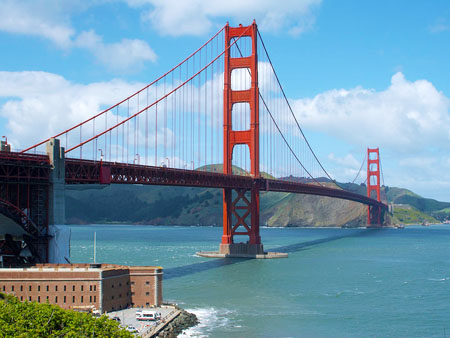
Suspension bridges are usually impressive and elegant by virtue of their enormous scale and characteristic naturally curving lines. The mass of a suspension bridge is literally hanging from the two massive cables draped over the tops of the two supporting pylons.
The steel-work of a bridge must be protected from the effects of corrosion, and is therefore painted at regular intervals if not perpetually. The colour of the paint may open up all sorts of photographic possibilities. Perhaps the best-known example of this is the Golden gate Bridge in San Francisco, California, which is painted a warm orange or red. The structure consequently glows in the light of the setting sun. Although not all suspension bridges are painted such an appropriate colour, and many do not have a magnificent backdrop comparable with San Francisco Bay, the colour may suggest a suitable time of day to capture images.
The most practicable viewpoints are of course to be found around the two ends of the bridge. In many cases a custom-built viewing area is accessible in the best available location. While this may provide an excellent view of the bridge, the images created are repeated by everyone who visits. To find something rather different, it is necessary to explore the area at either end of the bridge and be more creative. Try walking under the bridge, across its span and , if possible, exploring the options from the water.
The most unusual images of suspension bridges are obtained from high up in the structure, typically from the top of one of the towers. From here, several hundred feet above the roadway and water, there are incredible views of the both the whole structure and its surroundings. Access to such locations is unfortunately not normally open to photographers, but similar views can be obtained from a helicopter or light aircraft.
Whatever approach is used to photograph suspension bridges, be sure to capture the elegance of the curving suspension cables, and the apparent fragile nature of the gently arching bridge, in the best possible light and from a location that provides the best background and environmental context.